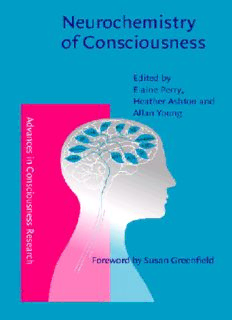Table Of ContentNeurochemistryofConsciousness
Advances in Consciousness Research
Advances in Consciousness Research provides a forum for scholars from
differentscientificdisciplinesandfieldsofknowledgewhostudyconsciousness
initsmultifacetedaspects.ThustheSerieswillinclude(butnotbelimitedto)
thevariousareasofcognitivescience,includingcognitivepsychology,linguis-
tics, brain science and philosophy. The orientation of the Series is toward
developingnewinterdisciplinaryandintegrativeapproachesfortheinvestiga-
tion, description and theory of consciousness, as well as the practical conse-
quencesofthisresearchfortheindividualandsociety.
SeriesA:TheoryandMethod.Contributionstothedevelopmentoftheoryand
methodinthestudyofconsciousness.
Editor
MaximI.Stamenov
BulgarianAcademyofSciences
EditorialBoard
DavidChalmers,UniversityofArizona
GordonG.Globus,UniversityofCaliforniaatIrvine
RayJackendoff,BrandeisUniversity
ChristofKoch,CaliforniaInstituteofTechnology
StephenKosslyn,HarvardUniversity
EarlMacCormac,DukeUniversity
GeorgeMandler,UniversityofCaliforniaatSanDiego
JohnR.Searle,UniversityofCaliforniaatBerkeley
PetraStoerig,UniversitätDüsseldorf
FranciscoVarela,C.R.E.A.,EcolePolytechnique,Paris
Volume36
NeurochemistryofConsciousness:Neurotransmittersinmind
EditedbyElainePerry,HeatherAshtonandAllanYoung
Neurochemistry of
Consciousness
Neurotransmitters in mind
WithaForewordbySusanGreenfield
Edited by
Elaine Perry
Heather Ashton
Allan Young
UniversityofNewcastle
Newcastle-upon-Tyne
JohnBenjaminsPublishingCompany
Amsterdam(cid:1)/(cid:1)Philadelphia
TM ThepaperusedinthispublicationmeetstheminimumrequirementsofAmerican
8
NationalStandardforInformationSciences–PermanenceofPaperforPrinted
LibraryMaterials,ansiz39.48-1984.
LibraryofCongressCataloging-in-PublicationData
Neurochemistryofconsciousness.Neurotransmittersinmind.WithaforewordbySusan
Greenfield/editedbyElainePerry,HeatherAshton,andAllanYoung.
p. cm.(AdvancesinConsciousnessResearch,issn1381–589X;v.36)
Includesbibliographicalreferencesandindex.
1. Consciousness. 2. Neurotransmitters. 3. Neurochemistry. 4. Neurobehavioral
disorders.I.Perry,E.K.(ElaineK.)II.Ashton,Heather.III.Young,Allan,1983-IV.Series.
QP411.N485 2002
153--dc21 2001052834
isbn902725156(cid:2)8(Eur.)/158811124(cid:2)5(US)(pbk.)
©2002–JohnBenjaminsB.V.
Nopartofthisbookmaybereproducedinanyform,byprint,photoprint,microfilm,orany
othermeans,withoutwrittenpermissionfromthepublisher.
JohnBenjaminsPublishingCo.·P.O.Box36224·1020meAmsterdam·TheNetherlands
JohnBenjaminsNorthAmerica·P.O.Box27519·Philadelphiapa19118-0519·usa
Table of contents
Foreword
SusanGreenfield
Preface
I. NeurotransmitterSystems
. Neurotransmitternetworks
ElainePerryandAllanYoung
. Cholinergictransmission:Novelsignaltransduction
NancyJ.Woolf
II. NaturalAlterationsofConsciousness
. Attention
AndrewScholey
. Memory
CarolineStewart
. Motivation:Rewardandpunishmentsystems
HeatherAshton
. Sleep:Slowwaveandnon-REMstages
AnnL.Sharpley
. Dreaming:Cholinergicanddopaminergichypotheses
MarkSolms
. Dreaming:Monoaminergicdisinhibitionhypothesis
ClaudeGottesmann
Tableofcontents
III. Drug-InducedAlterationsinConsciousness
. Generalanesthetics
PamelaFlood
. Effectsofdrugsonsleep
HeatherAshton
. Neuroleptics
CliveBallardandMargaretPiggott
. Deliriumandhallucinations
HeatherAshton
. Plantsofthegods:Ethnicroutestoalteredconsciousness
ElaineK.Perry
IV. BrainPathologyandConsciousness
. Alzheimer’sdisease:Focusonthecholinergicsystem
DanielI.Kaufer
. Parkinson’sdisease
DagAarslandandRandiStarrfelt
. DementiawithLewybodies:Adisorderofconsciousness?
MatthewWalkerandElainePerry
. Schizophrenia
GavinP.Reynolds
. Mooddisorders
R.HamishMcAllister-Williams
. Mentalretardationandautism
GregoryO’BrienandLouiseBarnard
Envoi
Index
Foreword
SusanGreenfield
The biggestquestion,arguably,thatanyscientistor indeedhuman beingcan
ask, is how the mass of tissue in the brain can generate the inner experi-
ence that we call consciousness: the state that no one else can access. How-
ever articulate, poetic, musical or close to someone you may be, that elusive
subjectivity,—the directfirst-hand‘feel’of the sunon yourface,orthe grass
between bare toes,—is quintessentially personal, utterly subjective. This si-
multaneouslyelusive,yetintimatephenomenonhas,ofcourse,keptdrovesof
philosophers occupied throughout the ages. But it is only in the last ten or
twentyyears,thatsciencehasactuallymovedin.
Sincescientistsaretrainedtobeutterlyobjective,—wedon’tevenusethe
activevoice,butpreferthefarmoreclumsy,passive;‘asolutionwasmadeup’
for example—it is small wonder that it goes against the grain now to bring
the machineryofscientificmethodtobearagainstsuch anintractabletarget.
Hencemanyscientists,includingandparticularlybrainscientists,tendtodis-
tancethemselvesfromthisareaofstudy,onthegroundsthatitisimpossible,
given current technologies and state of knowledge, to make any progress. As
oneparticularcolleagueofmine,anexpertonAlzheimer’sDisease,remarked,
“Ijusttakeconsciousnessforgranted”.Ontheotherhand,ifwearetoworkon
thebrain,thensurelysuchanapproachisindefensible:asthephilosopherJohn
Searle remarked, for brain scientists to ignore consciousness is like someone
workingonthestomachtosaytheyarenotinterestedindigestion.
Other scientists, nonetheless,fascinated by consciousness, simply cannot
raise the funds for empirical investigation. Given the mystic-like image the
word still conjures up to the mind-set of grant review panels, approaches
have been sardonically dubbed ‘a career limiting move’. But despite this
hostile culture there is, to their credit, a third, growing band of scientists
who, nonetheless,are squaring up to the problem.Curiously, however,brain
scientists have been conspicuously absent, in the early days, from this group
ofpioneers.Forexamplethemathematician,RogerPenrose,andthephysicist,
SusanGreenfield
Brian Josephson,havemade importantcontributionstothe field.Evenwhen
bio-medicalscientistsdotakethecentre-stage,asinthecaseofFrancisCrick,
or Gerry Edelman, an immunologist, they are not necessarily known from
their grounding in the basic brain sciences. An interesting feature, however,
oftheindividualsmentioned,isthatthereisahighproportionofNobelPrize
Winners!
Untilnow,itseems,onlythosewhoalreadyhaveastrongscientificreputa-
tionand,perhaps,thetimetoreflectontheseissuesawayfromthehurly-burly
of peer-review papers and grant writing are able to contemplate this biggest,
and most exciting question.However,the landscape is rapidly changing, and
nowanincreasingnumberofneuroscientistsareexploringwhatcontributions
theycanactuallymake.
We are now looking beyond the stumbling block of causality: the water
of neuronalsignalling, translatedinto the wine of subjective experience.The
philosopherDavidChalmershasreferredtothisimpasseasthe‘HardProblem’.
Where neurosciencenow might make a contribution,albeit a lessglamorous
one than coming up with a simple rubric for the conversion, is in showing
increasingly sensitive and precise correlations of consciousness, i.e. matching
uphowpeoplefeelwithwhatisoccurringinthebrain.
Giventhismorerealisticgoal,itissurprisinghowthefieldhaspreviously
been dominated by mathematical models of networks of neurons. We know
that such neuronal networks are quasi-permanent, slow to form, and highly
localwithinthebrain.Althoughtheymaybeabasisforlearningandmemory,
weknowthatyoucanbeconsciouswithoutlearningorrememberinganything
and,similarly,thatcomputerprocessescanoccurthatwillmodifyresponsesto
subsequentstimulus,butatthesametimedonotentailaconsciousexperience.
Ifwearetolookforacorrelationofconsciousness,thendrugsofferaperfect
RosettaStone,—afterall,bymanipulatingthechemicalsinourbrainwithcer-
taindrugs,wecan,ontheonehand,reportchangesinhowwefeelbut,atthe
sametime,matchthisupwiththechemistryofthebrain.Moreover,giventhat
psychoactivedrugsmodifyouremotions,anddosobymodifyingchemicalsin
thebrain,itfollowsthatemotionshaveachemicalbasis.Nowweconsiderthat
although learningandmemory can be dissociated fromconsciousness,emo-
tions cannot (we are always feeling something, howeverlow level). It follows
that clearly chemicals, forming the basis as they do of brain function, must
alsoformthebuildingblocksofconsciousness.
Howstrangethen,thatupuntilnow,thesilentsectorofthebrainresearch
communityhasbeentheneurochemistsandtheneuropharmacologists.
Foreword
Thisbook isnowsettobuckthe trend.Starting with ageneralintroduc-
tion to brain chemistry, the reader can take a journey through normal brain
processes,intotheworldofdrug-inducedchangesinconsciousness,andfinally
intothe chilling worldofdysfunctionsin consciousness.Subjects coveredare
trulycomprehensiveandofsuchanastonishingrange,thateventhededicated
brain specialist will be able to learn something, as well as the non-specialist,
andgainawonderfuloverviewofhowconsciousnessmighttakeplacewithin
the brain. The Hard Problem, of course, remains unsolved. But it is only by
a trulyscientific approach, such as found in these pages, that by building on
whatweknow,wewillbeabletomakeanyprogressatall.
Description:This book is a must read for anyone interested in the scientific study of consciousness. Neurochemicals, as well as emotion, are the two long forgotten aspects in the field that might do much to see how the puzzle could be put together. But this book has merits on content as well. It is the most com

